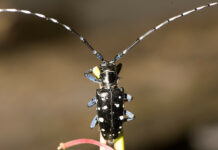
Robert Haight, a Forest Service researcher in St. Paul, Minnesota, has proposed a more strategic approach to saving ash trees: identifying beetle-infested trees before they show signs of damage. One way, he says, involves searching for woodpeckers.

The emerald ash borer (EAB) hides its eggs in bark crevices and tunnels deeply within trees — invisible to humans, but not to woodpeckers. They pick at the tree’s bark, searching for tasty grubs.
Along with other research colleagues from the Northern Research Station, the New Jersey Institute of Technology, and the College of Saint Rose, Haight has developed a new model that combines a map of a city’s ash trees with a summary of their health. Multiple health categories denote unaffected, newly infested, and long-term infested trees. These highly specific categories improve upon previous models, allowing for more accurate forecasts of tree health.

These forecasts help city planners economize EAB management. For example, they can decide where to protect healthy trees by inoculating them with insecticide and where to remove low-value specimens.
Trees can endure infestations for a few years before exhibiting outward signs of damage, like yellowing leaves and dying branches. Once branches begin to die, insecticides may no longer prevent damage and death. Detecting vulnerable trees early gives arborists and others more opportunities for intervention. This new model, combined with other treatment options, informs and improves ash tree defense.
Haight noted that tree care providers can track locations of potentially infested trees by searching for signs of the beetle — like woodpeckers. “Surveillance, chemical insecticides, removing low-value trees: together these activities provide a cost-effective strategy for protecting high-value ash trees,” said Haight.

For more on emerald ash borer, click here.











![[VIDEO] Dickies®: Discover Workwear That’s Anything But Uniform](https://turfmagazine.com/wp-content/uploads/2023/06/1647663814-4b1a2a7742790a9b1e97a3b963477850192e1d6a9dfba9b07214a77bae25d6e3-d-218x150.jpg)




























![[VIDEO] Dickies®: Discover Workwear That’s Anything But Uniform](https://turfmagazine.com/wp-content/uploads/2023/06/1647663814-4b1a2a7742790a9b1e97a3b963477850192e1d6a9dfba9b07214a77bae25d6e3-d-324x160.jpg)